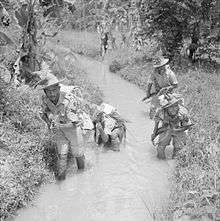9 Gorkha Rifles
| 9 Gorkha Rifles | |
|---|---|
 | |
| Active | 1817 – Present |
| Country |
|
| Branch | Army |
| Type | Rifles |
| Size | 5 Battalions |
| Regimental Centre | Varanasi, Uttar Pradesh |
| Motto(s) | Kafar Hunu Bhanda Marnu Niko (Better to die than live like a coward) |
| Colors |
Red faced yellow 1894 Dark Green; faced black |
| March | War Cry: Jai Maha Kali, Ayo Gorkhali (Hail Goddess Kali, The Gorkhas are here) |
| Decorations |
3 Victoria Cross 1 Ashoka Chakra 5 Param Vishist Seva Medals 5 Maha Vir Chakras 3 Kirti Chakras 6 Ati Vishist Seva Medals 17 Vir Chakras 7 Shaurya Chakras 13 Sena Medals 14 Vishist Seva Medals |
| Battle honours |
Post Independence Phillora,Kumarkhali and Dera Baba Nanak |
| Insignia | |
| Regimental Insignia | A pair of crossed Khukris with the numeral 9 below |
The 9 Gorkha Rifles is a Gorkha regiment of the Indian Army comprising Gurkha soldiers of Nepalese origin. The regiment was initially formed by the British in 1817, and was one of the Gurkha regiments transferred to the Indian Army after independence as part of the tripartite agreement in 1947. This Gorkha regiment mainly recruits soldiers who come from the Chhetri (Kshatriya) and Thakuri clans of Nepal. Domiciled Indian Gorkhas are also taken, and they form about 20 percent of the regiment's total strength. The 9 Gorkha Rifles is one of the seven Gorkha regiments of the Indian Army. The other regiments are 1 GR, 3 GR, 4 GR, 5 GR (FF), 8 GR and 11 GR.
History
Pre Independence
The history of the 9 Gorkha Rifles dates back to 1817, when it was raised as the "Fatehgarh Levy". In 1823, it was renamed the "63rd Regiment", and was formed as a regular unit as part of the Bengal Native Infantry. After the reorganisations that took place after the Indian Rebellion of 1857, the regiment's designation was changed to the "9th Bengal Native Infantry" with one of its companies formed by Gorkhas and the others by hillmen. By then the regiment had fought at Bhartpur and in the difficult Battle of Sobraon in the First Anglo-Sikh War.
By 1893, the regiment became a wholly Gorkha unit of Khas origin, accepting only those who were more closely linked to Hindu ways as compared to the Buddhist ways. In 1903, the regiment was designated 9th Gurkha Rifles.
9 GR fought in World War I in Europe,[1] and in the inter war years took part in the operations on the North West Frontier. It was soldiers of the regiment under the command of Brigadier General Reginald Dyer who fired into the crowd at the Amritsar Massacre.

In World War II, the regiment's battalions fought in Malaya,[2] Italy and North Africa.[3] The 3/9 GR and 4/9 GR formed part of the Chindit operations in Burma, and earned a reputation in the long range penetration operations. Stafford Beer served as an officer with the regiment 1945-7.[4]
Post Independence
India gained its independence in 1947 and 9 Gorkha Rifles was one of six Gurkha regiments (out of 10) allocated to the Indian Army as part of the Tripartite Agreement between Britain, India and Nepal.[5][6] Since 1947 the regiment has fought in the 1962 Indo-China War, the 1/9 GR fought under the most demanding conditions on the Namka Chu in (Arunachal Pradesh).
The battalions of the Regiment were involved in the 1965 and 1971 wars with Pakistan.
Designations
The regiment has existed since 1817 under the following designations:
- 1817–1819: Fatagarh Levy
- 1819–1824: Mianpuri Levy
- 1824–1861: 63rd Regiment of Bengal Native Infantry
- 1861–1885: 9th Regiment of Bengal Native Infantry
- 1885–1894: 9th Regiment of Bengal Infantry
- 1894–1901: 9th (Gurkha Rifle) Bengal Infantry
- 1903–1947: 9th Gurkha Rifles
- 1950–present: 9 Gorkha Rifles
Battle honours
The battle honours of the 9th Gorkha rifles are:[7]
- Pre-Independence: Bharatpur, Sobraon, Afghanistan (1879–80), Punjab Frontier,
- World War I: La Bassee, Festubert, Armentieres, Givenchy, Neuve Chapelle, Aubers, Loos, France and Flanders, Tigris, Kut-al-Amara, Mesopotamia,
- World War II: Malaya (1941–42), Djebel El Meida, Djebel Garci, Ragoubet Souissi, North Africa (1940–43), Cassino I, Hangman's Hill, Tavoleto, San Marino, Italy (1943–45), Chindits 1944, Burma (1942–45).
- Indo-Pak Conflict 1965: Phillora, Punjab 1965
- Indo-Pak Conflict 1971: Kumarkhali, East Pakistan 1971, Jammu and Kashmir 1971, Dera Baba Nanak, Punjab 1971
Victoria Cross recipients
- Major (later Lt. Colonel) George Campbell Wheeler, 2nd Battalion, 23 February 1917, River Tigris, Mesopotamia.[8]
- Temp. Major Frank Gerald Blaker, Highland Light Infantry, attached to 3rd Battalion, 9 July 1944, Taunggyi, Burma (now Myanmar).[9]
- Rifleman Sher Bahadur Thapa, 1st Battalion, 18 September 1944, San Marino, Italy.[10]
Notable members
- John Bradburne, M.C. (1921–1979), afterwards the "Vagabond of God"
- M N Rai, a colonel who received the Yudh Seva Medal for bravery and Shaurya Chakra posthumously.
- Bernard Dineen, (1923-2013), afterwards an award winning journalist for The Yorkshire Post
References
- Citations
- ↑ Parker 2005, pp. 102–103.
- ↑ Cross & Gurung 2007, p. 37.
- ↑ Parker 2005, pp. 164 &210.
- ↑ "Obituaries: Stafford Beer". The Telegraph. 28 August 2002. Retrieved 31 August 2015.
- ↑ Cross & Gurung 2007, pp. 169–171.
- ↑ Parker 2005, p. 224.
- ↑ Singh 1993.
- ↑ Parker 2005, p. 392.
- ↑ Parker 2005, p. 393.
- ↑ Parker 2005, p. 210.
- Bibliography
- Cross, J.P.; Gurung, Buddhiman (2007). Gurkhas at War: Eyewitness Accounts from World War II to Iraq. London: Greenhill Books. ISBN 978-1-85367-727-4.
- Parker, John (2005). The Gurkhas: The Inside Story of the World's Most Feared Soldiers. London: Headline. ISBN 978-07553-1415-7.
- Singh, Sarbans (1993). Battle Honours of the Indian Army 1757–1971. New Delhi: Vision Books. ISBN 8170941156.
External links
- 9 Gorkha Rifles at the Indian Army official Web site
- http://milhist.net/mto/19gurkha.html
- http://www.indianveterans.com/default_content.php?ssid=57
- http://www.defence.pk/forums/india-defence/26684-rare-pics-indian-army-regimental-boot-camp-gorkha-rifles.html
